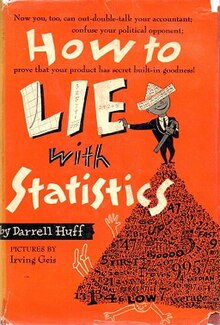

Sometimes statistical findings are linked so that it appears that two separate trends are related. Keep an eye out for this misleading technique, known as spurious correlation.
Check out this example from the site FiveThirtyEight. The blog Spurious Correlations, as the name suggests is full of even more examples.
Avoid falling victim to misleading or manipulative statistics by learning some statistics basics.
 How to Lie with Statistics
by
How to Lie with Statistics
by
Reference & Instruction Department
Fordham University Libraries
Walsh Library ♦ Rose Hill Campus ♦ 718-817-3586
Quinn Library ♦ Lincoln Center Campus ♦ 212-636-6050
Fordham Westchester Library ♦ Fordham Westchester Campus ♦ 914-367-3061
library@fordham.edu ♦ text 71-TXTX-1284 ♦ Ask a Librarian (Chat)